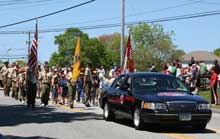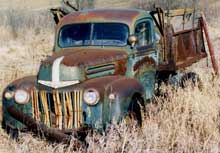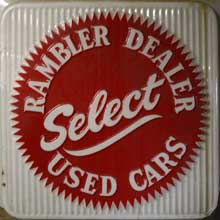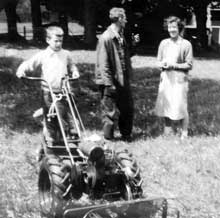Stepping Off
Our town does its parading on Memorial Day - actually the Sunday before Memorial Day. The Fourth of July is generally celebrated with family picnics or parades in other towns. Some 30 years ago, America's automakers did a disservice to the nation by discontinuing the production of convertibles, ever useful for parading lovelies and luminaries. For years the only convertible in our parades was a well-used 1967 Plymouth. Happily all that has changed. It's the 21st Century and convertibles are back.
Our memorial observances this year began with singing of the Star Spangled Banner, followed by raising the flag - then lowering it to half mast. The Silver Cornet Band played "God Bless America" and then the parade stepped off. The High School Band furnished mellow marching tunes, and Grand Marshal Chelsea Bateman, a winning essayist, was chauffeured in a red '58 Chevy Impala. There were no fewer than three fife and drum corps, one from as far away as Moodus. Boy Scouts from Troop 12, of which my son Edward is an Eagle alumnus, represented our side of town and our two fire departments had their best equipment in line. New this year was an emergency unit from the Salvation Army.
Convertibles there were aplenty, most carrying bevies of beauties. Interestingly, most were imports: Saab and BMW, but Mustang and Chrysler showed the flag for our home country. Jeep can be considered a convertible, and we had two, counting the sailors and Barbie. We always have a few antique cars, this year represented by a Model A Ford and a '55 Ford Victoria. For some reason, the lone '62 Chevy had its top up and no dignitaries aboard. A sweet '41 Ford coupe showed just a hint of rodding, a trait more prominent in the '38 Chevy behind it.
Memorial Day, of course, remembers our soldiers, and we had a pair of HMMWVs representing active duty and a convoy of historic military vehicles, from World War II WC Dodge to Korean era M37 to Deuce and a Half.
A parade is not a parade without floats. Sometimes they're less than inspired, but this year in addition to the traditional patriotic themes we had an innovative flying machine and a float that really floats, complete with rowing hands.
But not all was mechanized. Bringing up the rear was a mounted division, with their own motorized detachment for emission control.




